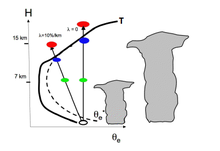逸入 (氣象學)
外觀

逸入是指大氣中的擾流捕捉到附近非擾流的過程。通常用在對流發展時,附近較乾氣塊進入對流氣柱中,與濕空氣混和的過程。
逸出則是與逸入相反,為對流氣柱中空氣離開氣柱、進入環境的過程。通常發生在對流氣柱的頂端。
理論
[編輯]
逸入是環境中的空氣與氣柱裡或雲裡的空氣混和的作用,部分環境中的空氣性質會進入到雲內。由於逸入作用會改變雲的性質,進而影響到降水、輻射...等,因此雲內的逸入係數設定對氣候模式的模擬影響相當大。[1]
逸入作用可分成同質及異質混和過程。同質混和過程是一個假設雲內混和作用的時間尺度小於蒸發的時間尺度的模式。這意味著當環境裡的未飽和乾空氣在使雲水蒸發之前,已有足夠的時間逸入到雲內,並與雲內空氣混和。透過同質混和過程的逸入作用,並不影響雲內的雲滴數量,只會使雲滴的部分液態水蒸發。[2][3] 與同質混和相對應的是異質混和過程,其雲滴蒸發的時間尺度短於混和的時間尺度,因此雲內的飽和氣塊會在逸入作用的區域被完全蒸發,使總雲滴數量減少。
這兩種模式的差距主要在於雲滴粒徑譜上的表現。在同質混和中,由於大、小雲滴的過飽和水氣壓並不相同,改變了粒徑分布曲線的形狀,因此同質混和後的雲滴粒徑分布將會變窄,而異質混和則不影響雲滴粒徑分布。
逸入率
[編輯]積雲在大氣中扮演著傳輸能量和水氣的重要角色,也影響著地球的氣候,但是在大尺度的模式當中,積雲無法直接被模擬而需要參數化。逸入率的決定又牽動著積雲內的性質,因此這個參數對積雲參數化來說相當重要。相關的研究中以Henry Stommel為積雲內逸入係數研究的先鋒科學家。[4]
參考資料
[編輯]- ^ Knight CG, Knight SHE, Massey N, Aina T, Christensen C, et al., (2007).
- ^ Jonas, P.R., (1996).
- ^ Lu C., Y. Liu, S. Niu, S. Krueger, and T. Wagner, 2013: Exploring parameterization for turbulent entrainment-mixing processes in clouds (頁面存檔備份,存於網際網路檔案館).
- ^ Stommel, H. Entrainment of air into a cumulus cloud.
更多相關
[編輯]- Lu C., S. Niu, Y. Liu, A. Vogelmann, 2013: Empirical relationship between entrainment rate and microphysics in cumulus clouds (頁面存檔備份,存於網際網路檔案館). Geophys. Res. Lett., 40, 2333-2338.
- Lu C., Y. Liu, and S. Niu, 2013: A method for distinguishing and linking turbulent entrainment mixing and collision-coalescence in stratocumulus clouds. Chin. Sci. Bull., 58, 545-551.
- Lu C., Y. Liu, S. Niu, A. Vogelmann, 2012: Lateral entrainment rate in shallow cumuli: Dependence on dry air sources and probability density functions (頁面存檔備份,存於網際網路檔案館). Geophys. Res. Lett., 39, L20812.
- Lu C., Y. Liu, S. Yum, S. Niu, S. Endo, 2012: A new approach for estimating entrainment rate in cumulus clouds (頁面存檔備份,存於網際網路檔案館). Geophys. Res. Lett., 39, L04802.
- Lu C., Y. Liu, and S. Niu, 2014: Entrainment mixing parameterization in shallow cumuli and effects of secondary mixing events (頁面存檔備份,存於網際網路檔案館). Chinese Sci. Bull., 59(9), 896-903.
- Lu C., Y. Liu, and S. Niu, 2011: Examination of turbulent entrainment-mixing mechanisms using a combined approach (頁面存檔備份,存於網際網路檔案館). J. Geophys. Res., 116, D20207.
- Burnet, F., and J.L. Brenguier, 2007: Observational Study of the Entrainment-Mixing Process in Warm Convective Clouds. J. Atmos. Sci., 64, 1995–2011.
- Chosson, F., J.L. Brenguier, and L. Schüller, 2007: Entrainment-Mixing and Radiative Transfer Simulation in Boundary Layer Clouds. J. Atmos. Sci., 64, 2670–2682.
- Hill, A.A., G. Feingold, and H. Jiang, 2009: The Influence of Entrainment and Mixing Assumption on Aerosol–Cloud Interactions in Marine Stratocumulus. J. Atmos. Sci., 66, 1450–1464.
- Hicks, E., C. Pontikis, and A. Rigaud, 1990: Entrainment and Mixing Processes as Related to Droplet Growth in Warm Midlatitude and Tropical Clouds. J. Atmos. Sci., 47, 1589–1618.
- Pontikis, C.A., and E.M. Hicks, 1993: Droplet Activation as Related to Entrainment and Mixing in Warm Tropical Maritime Clouds. J. Atmos. Sci., 50, 1888–1896.
- Baker, B.A., 1992: Turbulent Entrainment and Mixing in Clouds: A New Observational Approach. J. Atmos. Sci., 49, 387–404.
- Paluch, I.R., 1979: The Entrainment Mechanism in Colorado Cumuli. J. Atmos. Sci., 36, 2467–2478.
- Baker, M., and J. Latham, 1979: The Evolution of Droplet Spectra and the Rate of Production of Embryonic Raindrops in Small Cumulus Clouds. J. Atmos. Sci., 36, 1612–1615.
- Baker, M.B., R.G. Corbin, and J. Latham, 1980, The influence of entrainment on the evolution of cloud droplet spectra: I. A model of inhomogeneous mixing. Quarterly Journal of the Royal Meteorological Society, 106, 581-598.

